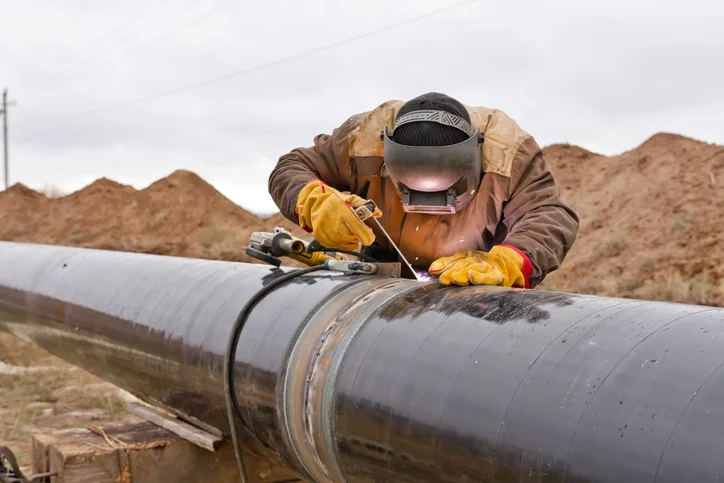Maximize Effectiveness: Proactive Pipeline Welding Inspection Strategies
Maximize Effectiveness: Proactive Pipeline Welding Inspection Strategies
Blog Article
Comprehensive Summary of Pipe Welding Examination Treatments
In the realm of pipeline building, making sure the honesty and safety of welded joints is vital. Pipe welding inspection procedures play an important duty in assuring that bonded links fulfill rigid industry requirements and requirements. From careful pre-welding examinations to comprehensive post-weld assessments, a well-defined evaluation procedure is crucial for preserving the structural sturdiness of pipelines. Comprehending the ins and outs of welding inspection procedures is not just a governing demand however likewise a basic element of supporting the reliability of these crucial infrastructures.
Pre-welding Assessment Preparations
Before commencing the welding procedure, complete pre-welding assessment prep work are vital to guarantee the integrity and top quality of the weld joint. These prep work involve a thorough assessment of the materials to be welded, the welding tools, and the job atmosphere. By conducting extensive pre-welding evaluation prep work, prospective problems can be identified and resolved early on, leading to trustworthy and high-grade weld joints.
Welding Procedure Qualification
Complete pre-welding evaluation prep work lay the structure for the essential process of Welding Procedure Qualification, ensuring the honesty and high quality of the weld joint. Welding Treatment Certification (WPQ) is a vital action in the welding process that entails testing and accrediting welding procedures to ensure they meet specific criteria and requirements. The WPQ process typically consists of welding procedure specification growth, welding treatment certification screening, and documents of the outcomes.
During welding treatment specification advancement, crucial details such as the welding procedure, welding materials, joint layout, and welding parameters are defined to develop a comprehensive treatment. Subsequently, welding procedure credentials screening is carried out to confirm the suggested treatment's honesty. This testing typically entails welding test promo codes that are subjected to different mechanical and non-destructive examinations to analyze the weld's quality and adherence to the specified requirements.
In-process Weld Examination
Throughout the welding process, in-process weld inspection plays a vital duty in guaranteeing the top quality and integrity of the weld joint - Pipeline Welding Inspection. This kind of assessment involves keeping an eye on the welding criteria, analyzing the weld grain development, and identifying any kind of potential defects or suspensions as they occur. By conducting in-process weld evaluations, welding look at these guys operators can quickly deal with any problems that may arise, therefore making sure and avoiding further defects that the last weld satisfies the required specifications
Usual techniques made use of for in-process weld evaluation consist of visual examination, liquid penetrant screening, magnetic particle testing, ultrasonic screening, and radiographic testing. Generally, in-process weld inspection is essential for keeping the high quality and integrity of bonded pipelines.
Non-destructive Screening (NDT)
Non-destructive Testing (NDT) is an important approach employed in pipe welding assessment to analyze the integrity of weld joints without triggering damages to the bonded framework. By utilizing various NDT methods, examiners can review the quality of welds and recognize any type of flaws or discontinuities that may jeopardize the architectural soundness of the pipeline. Usual NDT methods utilized in pipe welding inspection include Radiographic Screening (RT), Ultrasonic Screening (UT), Magnetic Particle Evaluating (MPT), Fluid Penetrant Screening (LPT), and Visual Testing (VT)
RT involves using X-rays or gamma rays to create pictures of the interior framework of the weld, permitting assessors to detect problems such as porosity, cracks, or incomplete blend. UT uses high-frequency sound waves to detect flaws beneath the surface of the weld, offering detailed information concerning the dimension and area of defects. MPT and LPT are used to identify surface-breaking defects by using penetrant fluids or magnetic bits to the weld location. Furthermore, VT includes visual inspection of welds to determine any type of visible blemishes.
Post-weld Inspection and Documents


Paperwork of post-weld inspection searchings for is important for keeping quality assurance records and guaranteeing conformity with industry criteria and regulations. Thorough records must consist of details about the examination methods used, the area and nature of any issues found, and any type of corrective actions taken - Pipeline Welding Inspection. Correct paperwork not just functions as a document of the weld's quality however likewise aids in future maintenance and assessment processes
Verdict

In verdict, pipeline welding inspection procedures play an important duty in making certain the this page quality and integrity of welds. Overall, adherence to proper assessment methods is key to the success of pipeline welding projects.
From meticulous browse around here pre-welding evaluations to extensive post-weld analyses, a distinct examination procedure is crucial for keeping the architectural strength of pipelines. By conducting in-process weld evaluations, welding operators can quickly deal with any issues that might occur, therefore protecting against more flaws and making sure that the last weld meets the required specs.
Usual techniques used for in-process weld inspection consist of visual inspection, liquid penetrant screening, magnetic fragment testing, ultrasonic screening, and radiographic testing.Non-destructive Testing (NDT) is a critical technique employed in pipe welding assessment to assess the honesty of weld joints without triggering damage to the welded structure. Post-weld assessment involves numerous techniques to analyze the welds for flaws, consisting of visual examination, dye penetrant screening, magnetic particle screening, ultrasonic testing, and radiographic testing.
Report this page